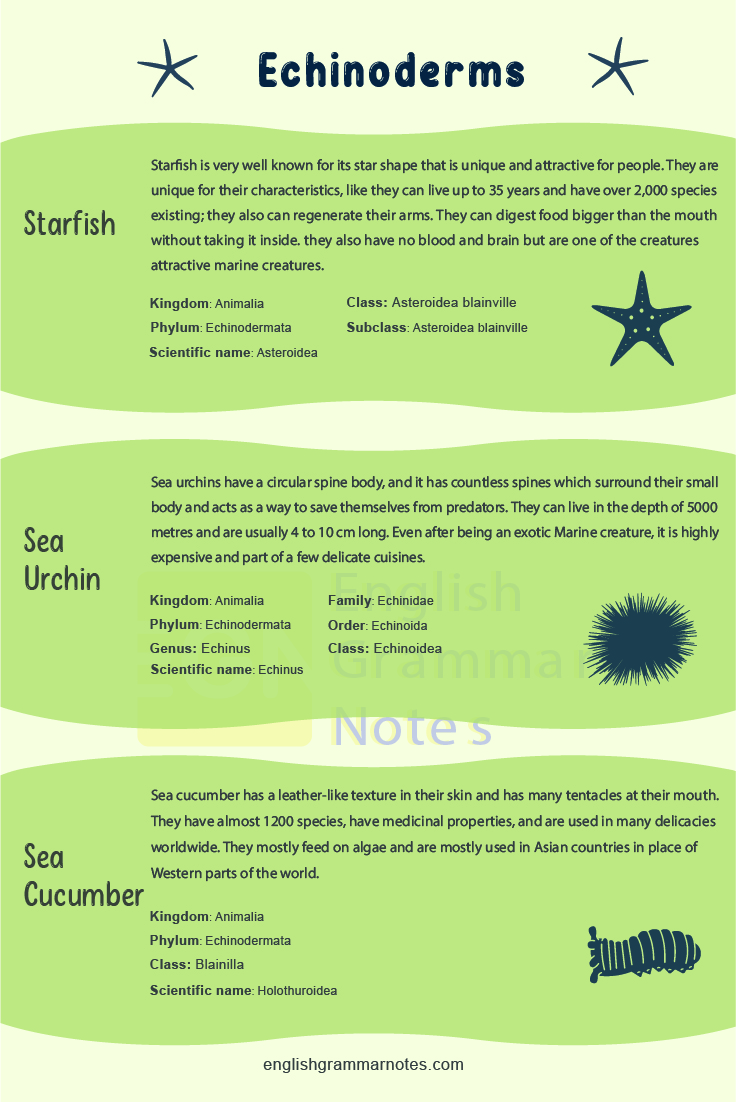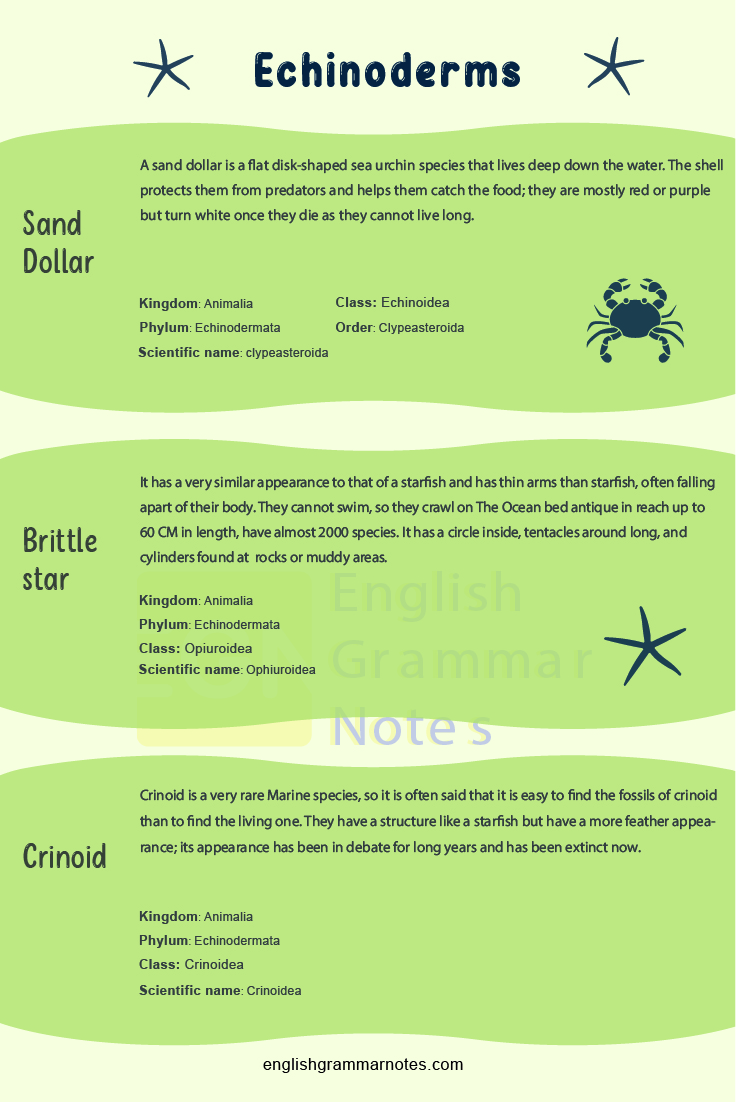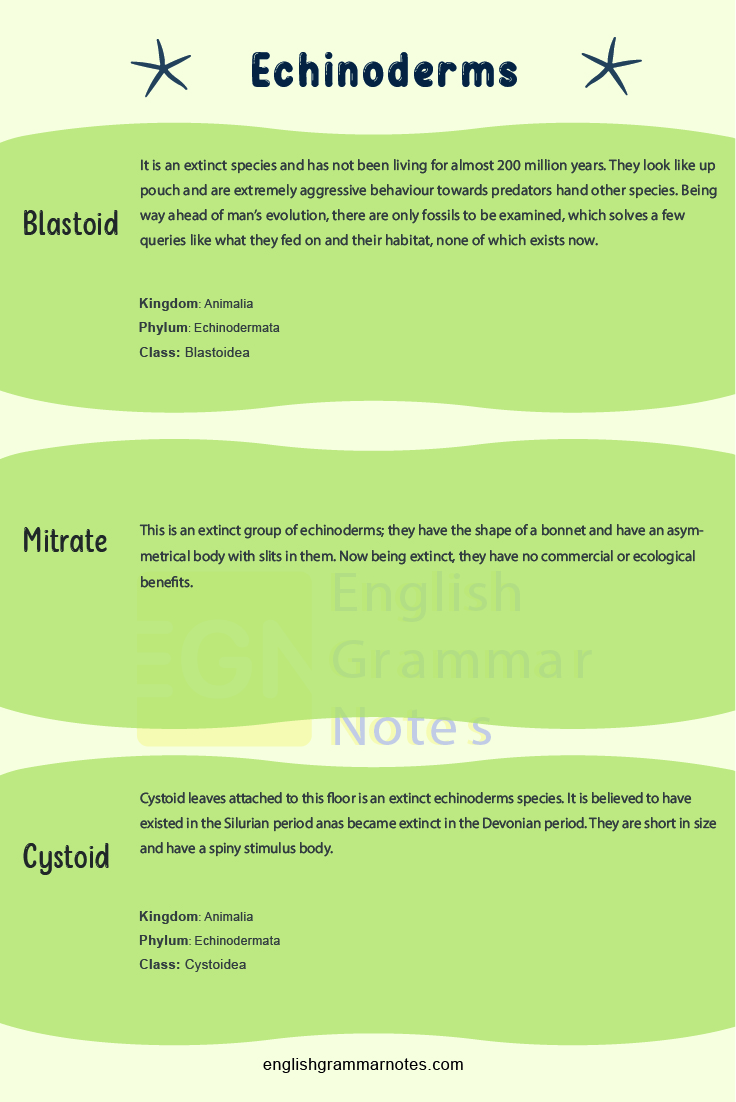Echinoderms: Marine animals are known to us, but marine wildlife is a new concept to many of us. The evolution of echinoderms dates back to the origin of the name from Greek, meaning spiny skin.
Classification of echinoderms is based on the distribution identification and their origin; starting with these might be stressful, so this blog will help you overcome all the problems.
Knowing about our habitat is necessary to gain knowledge and Interest. We have a bag full of echinoderms facts that you will love to know about. We have combined few names and made a list of echinoderms for you to know about them better.
Study the most important English Vocabulary Words identified by our experts and learn the right vocabulary to use in your day to day conversations
List of Echinoderms
Name of Echinoderms
Description of the Echinoderms of the list
Starfish
Starfish is very well known for its star shape that is unique and attractive for people. They are unique for their characteristics, like they can live up to 35 years and have over 2,000 species existing; they also can regenerate their arms. They can digest food bigger than the mouth without taking it inside. they also have no blood and brain but are one of the creatures—attractive marine creatures.
| Kingdom | Animalia |
| Phylum | Echinodermata |
| Superclass | Asterozoa |
| Class | Asteroidea blainville |
| Scientific name | Asteroidea |
Sea urchin
Sea urchins have a circular spine body, and it has countless spines which surround their small body and acts as a way to save themselves from predators. They can live in the depth of 5000 metres and are usually 4 to 10 cm long. Even after being an exotic Marine creature, it is highly expensive and part of a few delicate cuisines.
| Kingdom | Animalia |
| Phylum | Echinodermata |
| Class | Echinoidea |
| Order | Echinoida |
| Family | Echinidae |
| Genus | Echinus |
| Scientific name | Echinus |
Sea cucumber
Sea cucumber has a leather-like texture in their skin and has many tentacles at their mouth. They have almost 1200 species, have medicinal properties, and are used in many delicacies worldwide. They mostly feed on algae and are mostly used in Asian countries in place of Western parts of the world.
| Kingdom | Animalia |
| Phylum | Echinodermata |
| Class | Blainilla |
| Scientific name | Holothuroidea |

Sand dollar
A sand dollar is a flat disk-shaped sea urchin species that lives deep down the water. The shell protects them from predators and helps them catch the food; they are mostly red or purple but turn white once they die as they cannot live long.
| Kingdom | Animalia |
| Phylum | Echinodermata |
| Class | Echinoidea |
| Order | Clypeasteroida |
| Scientific name | clypeasteroida |
Mitrate
This is an extinct group of echinoderms; they have the shape of a bonnet and have an asymmetrical body with slits in them. Now being extinct, they have no commercial or ecological benefits.
Brittle star
It has a very similar appearance to that of a starfish and has thin arms than starfish, often falling apart of their body. They cannot swim, so they crawl on The Ocean bed antique in reach up to 60 CM in length, have almost 2000 species. It has a circle inside, tentacles around long, and cylinders found at rocks or muddy areas.
| Kingdom | Animalia |
| Phylum | Echinodermata |
| Class | Opiuroidea |
| Scientific name | Ophiuroidea |
Crinoid
Crinoid is a very rare Marine species, so it is often said that it is easy to find the fossils of crinoid than to find the living one. They have a structure like a starfish but have a more feather appearance; its appearance has been in debate for long years and has been extinct now.
| Kingdom | Animalia |
| Phylum | Echinodermata |
| Class | Crinoidea |
| Scientific name | Crinoidea |

Blastoid
It is an extinct species and has not been living for almost 200 million years. They look like up pouch and are extremely aggressive behaviour towards predators hand other species. Being way ahead of man’s evolution, there are only fossils to be examined, which solves a few queries like what they fed on and their habitat, none of which exists now.
| Kingdom | Animalia |
| Phylum | Echinodermata |
| Class | Blastoidea |
Eocrinoidea
This is one of the earliest extinct groups of eocrinoidea with all classes. It short body with regular moves to the upper surface searching for re-extending their arms. Like any other extinct species, it is not much known about them based on their fossils.
Cystoid
Cystoid leaves attached to this floor is an extinct echinoderms species. It is believed to have existed in the Silurian period anas became extinct in the Devonian period. They are short in size and have a spiny stimulus body.
| Kingdom | Animalia |
| Phylum | Echinodermata |
| Class | Cystoidea |
